IsaacT
0
- Joined
- Aug 25, 2010
- Messages
- 5,950
- Points
- 83
Is there a way to test a diode to make sure that:
1. The diode still works
2. The approximate wavelength of the diode
I need to know because I don't have any drivers since it is my first diode. I don't want to purchase a diode until I know that it isn't IR and more importantly, it hasn't been damaged by the extracting process. Thanks!
Below are thumbnails of the diode I am talking about, don't know if a picture will help but better safe than sorry.
1. The diode still works
2. The approximate wavelength of the diode
I need to know because I don't have any drivers since it is my first diode. I don't want to purchase a diode until I know that it isn't IR and more importantly, it hasn't been damaged by the extracting process. Thanks!
Below are thumbnails of the diode I am talking about, don't know if a picture will help but better safe than sorry.





